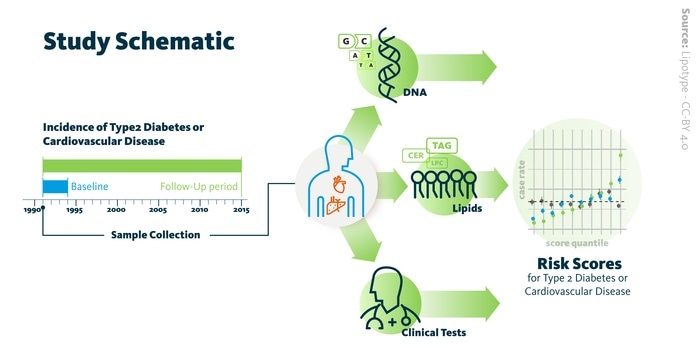According to a new study, simultaneous measurement of dozens of types of fats in the blood known as “lipidomics”, can predict the risk of type 2 diabetes (T2D) and cardiovascular disease (CVD) in the future. Such early detection using lipidomic profiling could pave the way for dietary and lifestyle changes to be recommended before the disease begins.

Study design schematic: Graphical outline of the cohort study to assess future type 2 diabetes and cardiovascular disease risk by integrating genetics, lipidomics, and standard clinical diagnostics. Image Credit: Lipotype.
The study was published on March 3rd, 2022, in the journal PLOS Biology by Chris Lauber of Lipotype, Germany, and colleagues.
Patient medical history and existing risk behaviors, as well as the levels and ratios of two key blood lipids such as high- and low-density cholesterol, are used to determine risk for T2D and CVD. However, the blood includes over a hundred different types of lipids, which are assumed to represent characteristics of metabolism and homeostasis all through the body, at least to some extent.
To see if a more complete measure of blood lipids could improve risk predictive performance, the researchers used data and blood samples from a longitudinal health survey of over 4,000 healthy, middle-aged Swedish citizens who were originally examined in 1991 and then tracked until 2015.
The concentrations of 184 lipids were measured using elevated, quantitative mass spectrometry on baseline blood samples. 13.8% of patients got T2D and 22% acquired CVD during the follow-up time.
The researchers used multiple training/test cycles on the data to generate the lipid-based risk level, using a randomly picked two-thirds of lipid data to generate a risk model and then checking if the model correctly predicts risk in the remaining third. Participants were classified into one of six subgroups based on their lipidomics profile after the model was established.
In comparison to the group averages, the highest-risk group had a chance of T2D of 37%, a 168% growth in risk. The highest-risk group had a CVD risk of 40.5%, and 84% elevated risk. The lowest-risk categories demonstrated a significant risk reduction when compared to the averages. The elevated risk for either disease was irrespective of known genetic risk factors and the length of years it took for the condition to manifest.
These discoveries could have several critical implications. On an individual basis, it may be able to identify risk years before disease manifestation, allowing for early intervention. Lipidomics may bring fresh insights into when and why disease occurs, either in combination with genetics and clinical records or independently. Furthermore, identifying the lipids that contribute the most to risk may lead to the discovery of new therapeutic options.
The lipidomic risk, which is derived from only one single mass-spectrometric measurement that is cheap and fast, could extend traditional risk assessment based on clinical assay.”
Chris Lauber, Lipotype
Individual lipids in the blood may also be the result of or assist a wide range of metabolic processes, making them potentially useful as indicators of those procedures. “The lipidome may provide insights much beyond diabetes and cardiovascular disease risk,” Lauber explained.
Strengthening disease prevention is a global joint effort with many facets. We show how lipidomics can expand our toolkit for early detection of individuals at high risk of developing diabetes and cardiovascular diseases.”
Chris Lauber, Lipotype
Source:
Journal reference:
Lauber, C., et al. (2022) Lipidomic risk scores are independent of polygenic risk scores and can predict incidence of diabetes and cardiovascular disease in a large population cohort. PLOS Biology. doi.org/10.1371/journal.pbio.3001561.